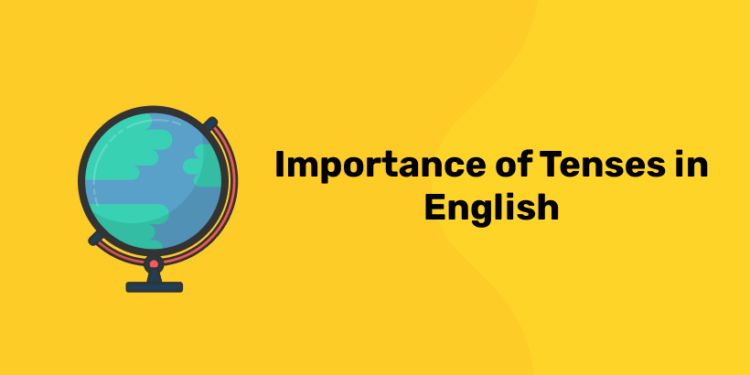Table of Contents
What Is a Tense?
We know tenses in English are important, but do you know what a tense is? Simply put, a tense is a form of a verb that allows us to express time.
For example, if you want to talk about something that happened last week, you would use the past tense. If you want to talk about something that will happen next month, you would use the future tense. When using tenses in English, we use the present (right now) as our point of reference because we are living in it.
So if you ate pizza yesterday, that action happened in the past, right?
The answer is “yes,” because it happened before the present time (before right now).
Since you ate pizza in the past, if you want to tell someone about it, you will have to use the past tense in English.
I ate pizza yesterday.
Now imagine you want to tell your friend about a trip to the mountains. This trip is going to happen in three days, so the trip is in the future. You cannot possibly use the same tense you used to say that you ate pizza yesterday. This time, you will have to use a different tense, one that expresses that an action will happen after our present time. That tense is the future simple tense:
I will go on a trip next Saturday.
Speak confidently and fluently with our Spoken English Course!
Why Learning the Tenses in English Is Important
1: Which of the sentences below is grammatically correct?
There are several reasons why you should know how to use the English tenses.
English is a chronological language.
This may sound scary, but it just means that English needs all its tenses in order to locate an action in time or express the relationship between two different actions.
For example:
She arrived yesterday. (The action happened in the past.)
She will arrive tomorrow. (The action will happen in the future.)
I was having a bath when the telephone rang. (There is a relationship between the two actions. Me having a bath was an action going on for some time in the past. The telephone ringing interrupted my bath.)
Tenses can help you say what you actually want to say.
This should be obvious. Each tense in English is used for one or more specific purposes. You will need to use one tense or another depending on what you want to say:
I drink water every day. (Repeated action.)
I am drinking water at the moment. (Action happening at the moment of speaking.)
I will drink water later. (Action in the future.)
Yesterday I drank a lot of water. (Action in the past.)
English is a world language.
English has become the main language of communication in the world. Millions and millions of people use it every day to communicate with friends, colleagues, bosses and more. If you want to be part of that world conversation, you should know English, and knowing English means knowing the tenses in English!
Tenses will help you get fluent.
Tenses will make the difference between being a beginner who can talk about their daily routine and speaking fluently about politics. The more tenses you learn, the better you will get at speaking English properly. A big difference between a beginner and an advanced learner is how well they know the tenses and how they use them.
| Download free PDFs on various aspects of the English language! | |
Learning tenses can improve all your language skills.
Grammar (and tenses) are present in everything we do in English, from telling the time to wishing a happy birthday to someone. We use tenses when we speak, listen to a podcast, watch a movie, read a book and more. So the more we know about tenses, the best we can apply our knowledge to all the other language skills.
Without tenses, passing your English exams would be impossible.
Finally, you need to learn the tenses if you want to pass your classes or ace (get high marks in) your official exams. Even if you are learning English on your own and you don’t plan on taking an exam, you must have a reason for learning, and because of that, you will want to know if you are making progress (getting better).
Spoken English Course for Guaranteed Confidence and Career Growth
Spoken English Course by Entri App: Enhance your communication skills, gain certification, and boost your career with confidence.
Join Now!Tenses and Their Functions
The table below gives an overview of some of the basic functions of tenses and aspects. Tenses locate an event in time, while aspects communicate durations and relationships between events that happen at different times.
| Tense | Function | Example |
|---|---|---|
| Present simple | used for facts, generalizations, and truths that are not affected by the passage of time | “She writes a lot of papers for her classes.” |
| Past simple | used for events completed in the past | “She wrote the papers for all of her classes last month.” |
| Future simple | used for events to be completed in the future | “She will write papers for her classes next semester.” |
| Present perfect | used to describe events that began in the past and are expected to continue, or to emphasize the relevance of past events to the present moment | “She has written papers for most of her classes, but she still has some papers left to write.” |
| Past perfect | used to describe events that happened prior to other events in the past | “She had written several papers for her classes before she switched universities.” |
| Future perfect | used to describe events that will be completed between now and a specific point in the future | “She will have written many papers for her classes by the end of the semester.” |
| Present continuous | used to describe currently ongoing (usually temporary) actions | “She is writing a paper for her class.” |
| Past continuous | used to describe ongoing past events, often in relation to the occurrence of another event | “She was writing a paper for her class when her pencil broke.” |
| Future continuous | used to describe future events that are expected to continue over a period of time | “She will be writing a lot of papers for her classes next year.” |
| Present perfect continuous | used to describe events that started in the past and continue into the present or were recently completed, emphasizing their relevance to the present moment | “She has been writing a paper all night, and now she needs to get some sleep.” |
| Past perfect continuous | used to describe events that began, continued, and ended in the past, emphasizing their relevance to a past moment | “She had been writing a paper all night, and she needed to get some sleep.” |
| Future perfect continuous | used to describe events that will continue up until a point in the future, emphasizing their expected duration | “She will have been writing this paper for three months when she hands it in.” |
When to use the present simple
The present simple is the most commonly used tense in academic writing, so if in doubt, this should be your default choice of tense. There are two main situations where you always need to use the present tense.
Join our Spoken English program today and communicate with ease!
Describing facts, generalizations, and explanations
Facts that are always true do not need to be located in a specific time, so they are stated in the present simple. You might state these types of facts when giving background information in your introduction.
- The Eiffel tower is in Paris.
- Light travels faster than sound
Similarly, theories and generalizations based on facts are expressed in the present simple.
- Average income differs by race and gender.
- Older people express less concern about the environment than younger people.
Explanations of terms, theories, and ideas should also be written in the present simple.
- Photosynthesis refers to the process by which plants convert sunlight into chemical energy.
- According to Piketty (2013), inequality grows over time in capitalist economies.
Describing the content of a text
Things that happen within the space of a text should be treated similarly to facts and generalizations.
This applies to fictional narratives in books, films, plays, etc. Use the present simple to describe the events or actions that are your main focus; other tenses can be used to mark different times within the text itself.
- In the first novel, Harry learns he is a wizard and travels to Hogwarts for the first time, finally escaping the constraints of the family that raised him.
The events in the first part of the sentence are the writer’s main focus, so they are described in the present tense. The second part uses the past tense to add extra information about something that happened prior to those events within the book.
When discussing and analyzing nonfiction, similarly, use the present simple to describe what the author does within the pages of the text (argues, explains, demonstrates, etc).
- In The History of Sexuality, Foucault asserts that sexual identity is a modern invention.
- Paglia (1993) critiques Foucault’s theory.
This rule also applies when you are describing what you do in your own text. When summarizing the research in your abstract, describing your objectives, or giving an overview of the dissertation structure in your introduction, the present simple is the best choice of tense.
- This research aims to synthesize the two theories.
- Chapter 3 explains the methodology and discusses ethical issues.
- The paper concludes with recommendations for further research.
Elevate your speaking skills with our Spoken English Course!
When to use the past simple
The past simple should be used to describe completed actions and events, including steps in the research process and historical background information.
Reporting research steps
Whether you are referring to your own research or someone else’s, use the past simple to report specific steps in the research process that have been completed.
- Olden (2017) recruited 17 participants for the study.
- We transcribed and coded the interviews before analyzing the results.
The past simple is also the most appropriate choice for reporting the results of your research.
- All of the focus group participants agreed that the new version was an improvement.
- We found a positive correlation between the variables, but it was not as strong as we hypothesized.
Describing historical events
Background information about events that took place in the past should also be described in the past simple tense.
- James Joyce pioneered the modernist use of stream of consciousness.
- Donald Trump’s election in 2016 contradicted the predictions of commentators.
When to use the present perfect
The present perfect is used mainly to describe past research that took place over an unspecified time period. You can also use it to create a connection between the findings of past research and your own work.
Summarizing previous work
When summarizing a whole body of research or describing the history of an ongoing debate, use the present perfect.
- Many researchers have investigated the effects of poverty on health.
- Studies have shown a link between cancer and red meat consumption.
- Identity politics has been a topic of heated debate since the 1960s.
- The problem of free will has vexed philosophers for centuries.
Similarly, when mentioning research that took place over an unspecified time period in the past (as opposed to a specific step or outcome of that research), use the present perfect instead of the past tense.
- Green et al. have conducted extensive research on the ecological effects of wolf reintroduction.
Emphasizing the present relevance of previous work
When describing the outcomes of past research with verbs like find, discover or demonstrate, you can use either the past simple or the present perfect.
The present perfect is a good choice to emphasize the continuing relevance of a piece of research and its consequences for your own work. It implies that the current research will build on, follow from, or respond to what previous researchers have done.
- Smith (2015) has found that younger drivers are involved in more traffic accidents than older drivers, but more research is required to make effective policy recommendations.
- As Monbiot (2013) has shown, ecological change is closely linked to social and political processes.
Note, however, that the facts and generalizations that emerge from past research are reported in the present simple.
When to use other tenses
While the above are the most commonly used tenses in academic writing, there are many cases where you’ll use other tenses to make distinctions between times.
Future simple
The future simple is used for making predictions or stating intentions. You can use it in a research proposal to describe what you intend to do.
It is also sometimes used for making predictions and stating hypotheses. Take care, though, to avoid making statements about the future that imply a high level of certainty. It’s often a better choice to use other verbs like expect, predict, and assume to make more cautious statements.
- There will be a strong positive correlation.
- We expect to find a strong positive correlation.
- H1 predicts a strong positive correlation.
Similarly, when discussing the future implications of your research, rather than making statements with will, try to use other verbs or modal verbs that imply possibility (can, could, may, might).
- These findings will influence future approaches to the topic.
- These findings could influence future approaches to the topic.
Elevate your speaking skills with our Spoken English Course!
Present, past, and future continuous
The continuous aspect is not commonly used in academic writing. It tends to convey an informal tone, and in most cases, the present simple or present perfect is a better choice.
- Some scholars are suggesting that mainstream economic paradigms are no longer adequate.
- Some scholars suggest that mainstream economic paradigms are no longer adequate.
- Some scholars have suggested that mainstream economic paradigms are no longer adequate.
However, in certain types of academic writing, such as literary and historical studies, the continuous aspect might be used in narrative descriptions or accounts of past events. It is often useful for positioning events in relation to one another.
- While Harry is traveling to Hogwarts for the first time, he meets many of the characters who will become central to the narrative.
- The country was still recovering from the recession when Donald Trump was elected.
Past perfect
Similarly, the past perfect is not commonly used, except in disciplines that require making fine distinctions between different points in the past or different points in a narrative’s plot.
How to Learn Tenses in English
Learning tenses can be quite boring sometimes, especially if you are trying to learn by yourself. Boring also means ineffective, so what can we do to learn fast without wasting our time? I have been teaching English for almost two decades (20 years) and I have used many different methods with my students. I have also been (and still am) on the other side of the teacher-student coin. I learn languages as a hobby, and I myself use different learning methods and techniques depending on the situation and the language. Many of my students love self-studying English, but they get lost sometimes, especially when they start learning the tenses.However, I have found there are some tips that are better than others when you want to learn English grammar tenses.
Divide them into past, present and future tenses.
You can use the division past, present and future to have three groups of four tenses. This division is great if you want to learn everything about a specific “chunk” (piece) of the line of time without worrying too much about the rest, so it is a good technique for beginner learners who are still not ready to mix points in time. For example, first you can focus on the present tenses, then the past tenses and then the future tenses.
Divide them into pairs.
Another way of dividing the different tenses is by making pairs. As you learn more, you will realize that very often tenses share certain features or like to appear together in sentences.
There are different ways of making this division:
- Simple and continuous tenses: present simple and present continuous, past simple and past continuous, future simple and future continuous.
- Perfect and perfect continuous tenses: present perfect and present perfect continuous, past perfect and past perfect continuous, future perfect and future perfect continuous.
- Tenses that normally appear together in sentences: present simple and present perfect, present simple and present continuous, past simple and present perfect, past simple and past continuous, past simple and past perfect.
These are only some examples.
You can divide the tenses in a different way if you feel two (or more) tenses go together. I recommend this technique for intermediate and advanced learners because tenses get mixed and used together.
Practice with online exercises and apps.
There are millions of online resources you can use to practice tenses in English. And if you prefer learning on the go, you can also download one or more apps and use them to become a master of the language.
Create your own sentences.
I recommend you choose one tense at a time and practice writing sentences, negative sentences and questions with it. Write as many examples as you can think of, focusing on one tense at a time. This will help you memorize the structure of the tense in all its forms and allow you to use it more naturally.
Watch series, movies and videos to see tenses in context.
Context is everything, and the more context we have, the better we understand what is being said. The best thing about any type of native English video is that you are not only listening to native speakers talk (so you are practicing pronunciation) but also listening to full sentences in context. When you listen to a tense being used in context, you will be able to understand why it is being used, so you will know when to use it by yourself.
Create flashcards for each tense and how they are used.
You can do this in two separate decks (one for the uses of each tense and one for the way they are built), or put all the information together on both sides of a flashcard. Do whatever feels best for you. The most important thing is that you keep on practicing.
Create your own short stories.
This kind of exercise is recommended for intermediate and advanced learners. Think of a story and try to write three different versions of it, one in the past, one in the present and one in the future. At the beginning, this can feel a little bit difficult, but it will get easier as you go.
You can write about anything you want.
- Daily routines (Describe yesterday, a normal day in your life and tomorrow.)
- Your lives (Who were you in a past life? Who are you know? Who do you want to be in the future?)
- Cities (Write about how they were in the past, how they are now and how you think they will be in 100 years.)
- Favorite singer/writer/actor (Choose one who is already dead and one who is still alive. For the future tense, write about your favorite alive artist in 10 years. Where will they be? What will they do? Will they be married? Will they have kids?)
- Think about an important historical event and write about it by using past tenses. Now imagine the same event is happening now. Change your story accordingly.
Read, read, read!
Reading is one of the best exercises we can do if we really want to understand tenses and learn how to use them properly. You will not think you are learning anything while you are reading, but the truth is that your brain is learning how to recognize different tenses and language structures that get repeated, and before you know it, you will start using English tenses like a boss.
Join our Spoken English program today and communicate with ease!
Listen to podcasts and the radio.
Listening to English spoken by native speakers is also a superb way of practicing tenses. When you listen to proper English, much as when you read it, you are feeding your brain with correct structures. With time, your brain will recognize these structures and give you a hand when you want to say something in English.











